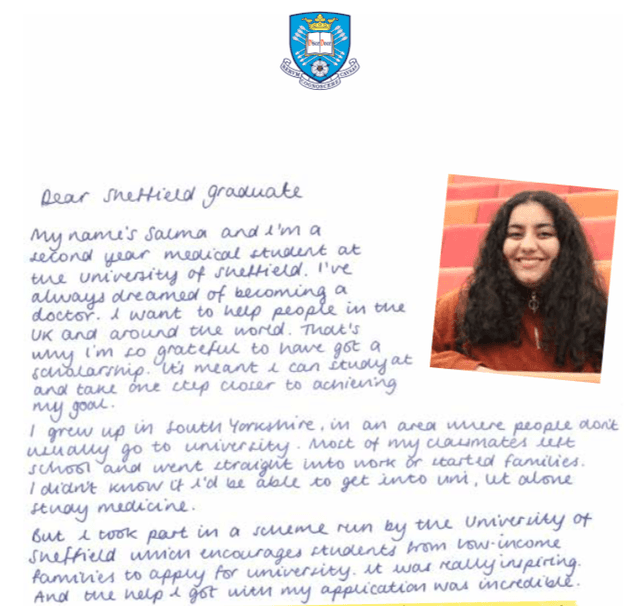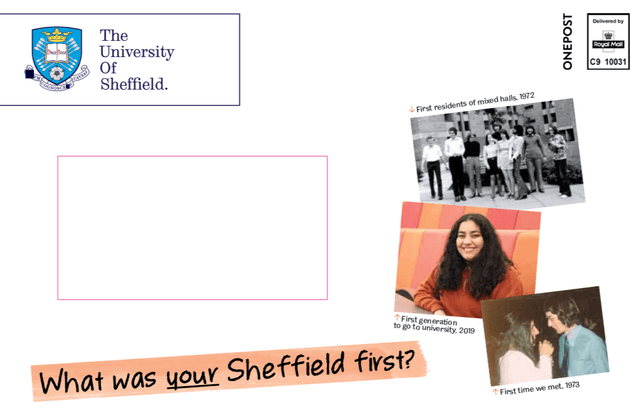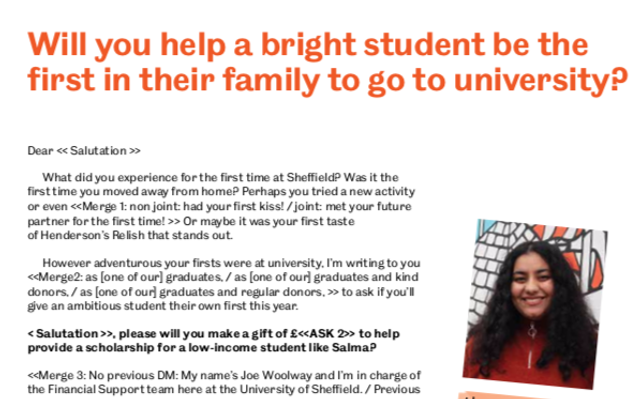University of Sheffield: Direct mail – the longer the better? Two page vs. four page letters
- Exhibited by
- Heather Clement
- Added
- September 05, 2019
- Medium of Communication
- Direct Mail
- Target Audience
- Alumni
- Type of Charity
- Higher education
- Country of Origin
- UK
- Date of first appearance
- 2019
SOFII’s view
The University of Sheffield wanted to test the theory that a longer letter would improve their results, so boldly challenged their own assumptions with a split campaign between a short and a long letter. And the results came back resoundingly in favour of the longer letter. This campaign is a great reminder that if you are unsure in fundraising, it never hurts to split test.
Summary / objectives
Direct mail best practice tells us that the ‘longer the letter, the better the response’. Having always used two-page letters previously, the University of Sheffield was keen to see if they could improve results by using a longer one.
Background
The University of Sheffield has been sending alumni direct mail in order to raise money for student scholarships every year since 2017. With a limited budget, the University of Sheffield currently produces all direct mail in-house (using a local agency for design, print and fulfilment). Income from direct mail had grown but in order to grow it further in 2019, whilst still being cost-effective, Sheffield needed to try a different approach. Advised by Adrian Salmon from GG+A consultancy, it was recommended that Sheffield try a longer letter as part of the mail pack.
When proposing this idea to colleagues, common worries about sending longer letters were:
- We don’t want to ‘bombard’ alumni with too much information.
- Alumni don’t have time to read a two-page letter in full, let alone four pages.
- Alumni will be concerned that we’re being frivolous and wasting money or paper.
- A longer letter will cost much more.
- A longer letter will contain more waffle to ‘pad it out’ and won’t be as concise.
However, as best practice also backed up this theory about longer letters, Sheffield decided to carry out a split test to see if the theory would work with their alumni-base for their 2019 direct mail appeal.
Creator / originator
Heather Clement, Regular Giving Manager, University of Sheffield
Influence / impact
The appeal showed the University of Sheffield that longer letters will generate better results from their alumni than shorter letters. This may be due in part to the following:
- There’s more space to showcase the need – more space to tell stories in full and persuade the reader that there is a compelling need for support.
- There’s more space to repeat key messages – repetition helps to bring the message home and persuade the reader to support.
- More space means you can make better use of fixing points – what use is a fixing point if it’s crammed onto a page with too many other distractions?
- Using a longer letter, shows a prospect that you’re serious about their contribution – showing you’ve dedicated time, money and space in order to appeal to them may mean they’re more inclined to take the proposition seriously.
Test details
The prospect pool was segmented based on constituent behaviour and separated into non donors, cash donors and regular donors.
Half of each segment were selected at random and received the four page letter.
The four-page letter pack was sent to:
- c. 11,000 non donors
- c. 1,600 cash donors
- c. 600 regular donors
Roughly the same number of constituents from each segment received the two page letter pack.
The four-page letter pack was also sent to:
- A group of non donors who were known prospects with a higher giving capacity c. 3,000
- A group of donors who had given over £200 before to a direct mail – c. 300
- These two groups have been excluded from the results for fairness.
Other elements of the pack were all identical for both two- and four-page letter versions:
- Outer envelope.
- Two-sided A4 donation form with tear-off response device.
- Two-sided A5 lift note
- BRE.
Costs
The two-page letter pack cost 72p, while the four-page letter pack cost 78p
Results
The four-page letter pack raised over twice as much as the two-page letter pack and had a significantly higher average gift value and income per constituent. More constituents gave to the four-page letter pack and it yielded almost double the return on investment.
|
| Funds secured | No. gifts | Average gift value | Participation rate | Income per constituent | ROI |
| Two-page letter pack | £20,587 | 248 | £279 | 1.8% | £1.53 | £2.12 |
| Four-page letter pack | £43,883 | 293 | £435 | 2.2% | £3.25 | £4.18 |
Across both cash-donor and non-donor segments, the four-page letter generated better results.
The only exception was among regular donors which produced more similar results from both packs across a range of measures (although there was a smaller pool to test this on). In fact, the two-page letter pack raised more money and had a slightly higher average gift value. This may show that donors who are already giving regularly may feel that a four-page letter asking them for an additional cash gift is ‘too much’ when they are already giving. Whereas the two-page letter may have felt more appropriate for this group.
Merits
This appeal tests a long-understood theory in fundraising direct-mail by using a large data-set and keeping the other elements of the appeal identical. Upscaling from a two-page to a four-page letter pack was proven to be a highly cost effective and a simple change that could be replicated by other organisations to vastly improve results.
This was the most successful Direct Mail cash appeal that the University of Sheffield has ever produced, raising £106,000 in total, and acquiring more cash donors and four-figure gifts than ever before





















